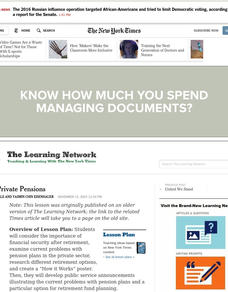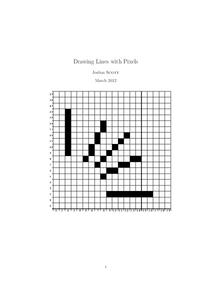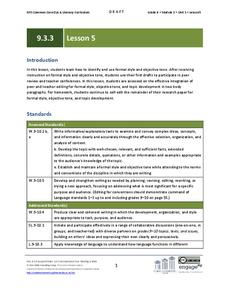Virginia Department of Education
Organizing Topic: Data Analysis
Learners engage in six activities to lead them through the process of conducting a thorough analysis of data. Pupils work with calculating standard deviations and z-scores, finding the area under a normal curve, and sampling...
California Department of Education
Choosing My Lifestyle
How much does it cost to live the life your dream life? Scholars explore the pitfalls of personal finance through planning, discussion, and research. The first lesson in a five-part series tasks individuals with determining an...
US Institute of Peace
Defining Conflict
Conflict is everywhere—but is it avoidable? The first activity in a series of 15 peacebuilding lessons examines the nature of conflict at home, school, and across the world. Learners develop a definition of conflict through group work...
Healthy Native Youth
Chapter 7: Revisiting the Circle of Life
Scholars revisit the Circle of Life to examine positive character traits—mental, physical, spiritual, and emotional. Pupils discuss how those character traits could help them make responsible decisions and not contract HIV/AIDS. Learners...
Curated OER
Formatting Fun
Launch this lesson by saving the provided Formatting Fun template on your classroom or library computers. Young learners can then practice formatting basics for use in writing activities. Exercises include practice in highlighting text,...
Curated OER
Coordinate Plane
Students use computer applets to demonstrate three dimensional coordinate planes. In this coordinate planes lesson plan, students play a coordinate game and a maze game.
Curated OER
ICT/Literacy
Deepen understanding of email correspondence. Begin by tapping into prior experience with email and word processing. Learners then send emails to one another, practicing attaching images and copying and pasting their work into a word...
Curated OER
Getting to Know Numbers
Learners study the math concepts associated with the calendar including days of the week, months of the year, odd/even numbers and numbers which come before and after. They use handheld computers with the appropriate software.
Curated OER
Calico Watercolor Cats
A fun art project, this lesson incorporates math and listening skills as young artists play with a new painting technique. First the teacher models how to draw a cat using shapes, an oval for the body, triangles for the ears and so on,...
Curated OER
3-D Cubes
Students investigate cubes. In this geometric solids instructional activity, students review geometric concepts previously taught, then logon to a computer game in which they find cube figures and identify the shadow of hidden cubes.
Curated OER
When Moore Is Less for Microprocessors
High schoolers in technology classrooms review how microprocessors work, examine Moore's Law, and relate it to the predicted end that is in sight for silicon dioxide-based transistors used in billions of chips.
Curated OER
Catapults
Students discover the catapult. In this catapult lesson, students research the history of the catapult and how it works. They work in groups to build their own catapult using tootpicks, popsicle sticks, rubber bands, and spoons.
Curated OER
Elements of Chemistry: Atoms: The Building Blocks of Matter
Students explore scientific theories and the works of scientists. In this chemistry lesson students develop a timeline that shows how scientists work was built on the ones before them.
Curated OER
Saving Private Pensions
Students consider the importance of financial security after retirement, examine current problems with pension plans in the private sector, research different retirement options, and create a "How it Works" poster.
Curated OER
Tangled Text
Students list different forms of communication, assess importance of writing, read and discuss article "String, and Knot, Theory of Inca Writing", research system of writing, and create "How It Works" posters.
Curated OER
Shedding New Light
Students consider why photographs in space might not show stars and research the importance of light in this phenomenon. They research other scientific processes related to light or its absence and create "How It Works" posters about them.
Curated OER
Examining a Microchip
In this computer technology lesson students investigate silicon microchips. Students explore microchip technology using a microscope. Lesson contains hands on investigations.
Curated OER
Beginning Understanding of Computers and the Internet
Students explore the use of a computer and the Internet. In this beginning computers lesson students students show what they know about the computer and Internet and demonstrate their skills. They investigate the computer training...
Computer Science Unplugged
Drawing Lines with Pixels
How do the computers keep it straight? Using the provided algorithms, class members draw a line and a circle using pixels. They then check the drawings using a straight edge and compass to determine the accuracy of their...
TryEngineering
Circuits and Boolean Expressions
Teach basic logic using Boolean operators. Young computer scientists learn about the operators NOT, AND, and OR, and how they can be expressed using Boolean notation, logic gates, or truth tables. Along the way, they learn about half...
Beauty and Joy of Computing
Nesting Lists
Create lists within lists. The second lab in a series of five in the unit has pupils develop a simple contact list app. The tasks within the lab build the need for an abstract data type. Individuals build more complexity into their...
Curated OER
How Credit Card Interest Works
Students experiment with an Excel spreadsheet model that demonstrates the effects of interest on payments. They calculate actual costs, interest paid, and time necessary to pay off credit purchases and draw conclusions about the...
Curated OER
How Communication Technologies Affect People
Third graders complete a worksheet, first with known information, and then with researched information. They create a PowerPoint, video, or radio broadcast to convey the results of their research. They learn to use a graphic organizer to...
EngageNY
Grade 9 ELA Module 3, Unit 3, Lesson 5
Class members examine examples that model how to develop and maintain a formal style and an objective tone in informative/explanatory writing. They also engage in a peer review activity and revise their work based on the feedback.























